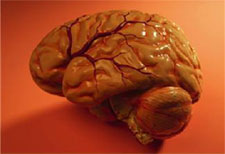
Your body most frequently uses negative feedback loops to maintain homeostasis. The thermostat example in section 1 is an example of a negative feedback loop. The thermostat was set at a target temperature of 75°F. When the temperature in the house went above 75°F, the air conditioner came on and stayed on until the temperature returned to the target temperature.
In negative feedback loops, your body experiences a change and does something to neutralize that change. In other words, your body senses an internal change or stimulus that varies from the target or normal condition. The body then produces a response to reverse the change.

Regulation of body temperature is a classic example of a negative feedback loop. The target set point for human body temperature is 98.6°F or 37°C. If the body temperature changes, the hypothalamus in the brain sends a message to the skin.
![]() Click on the response buttons below to see how the body responds when the internal body temperature changes.
Click on the response buttons below to see how the body responds when the internal body temperature changes.

Another example of a negative feedback loop is hydration. Your body needs a lot of water to carry on its processes. If your body is low on water, it signals you to drink by giving you a thirst sensation and making your lips dry and chapped. When you have had enough water, and your water is in balance, your thirst dissipates. Proper hydration requires enough water, but not too much water.